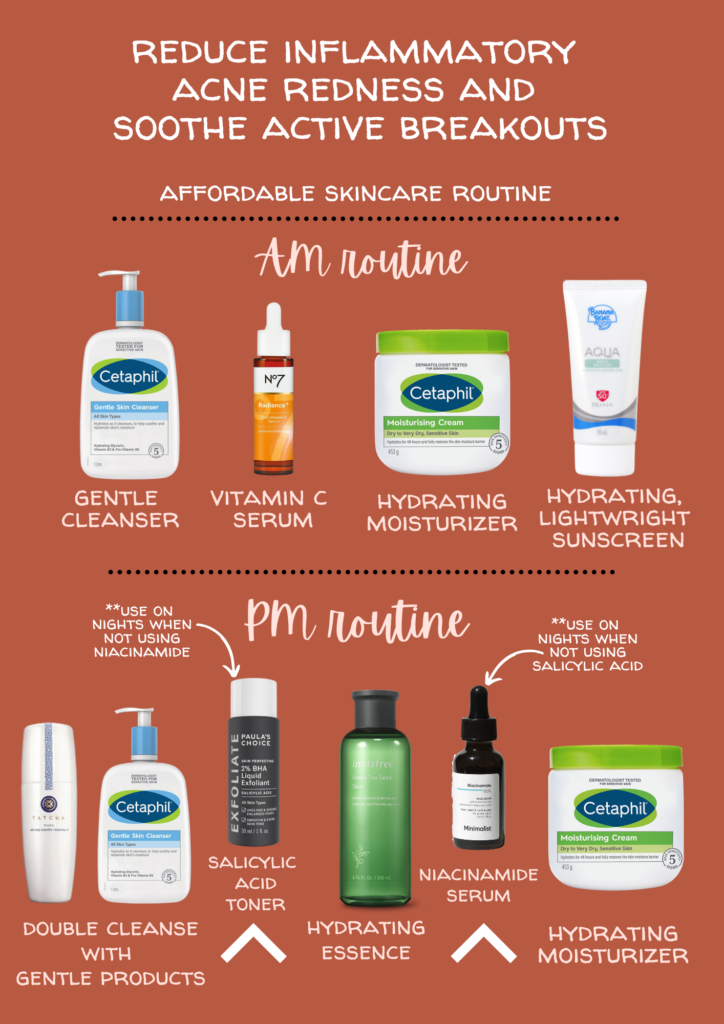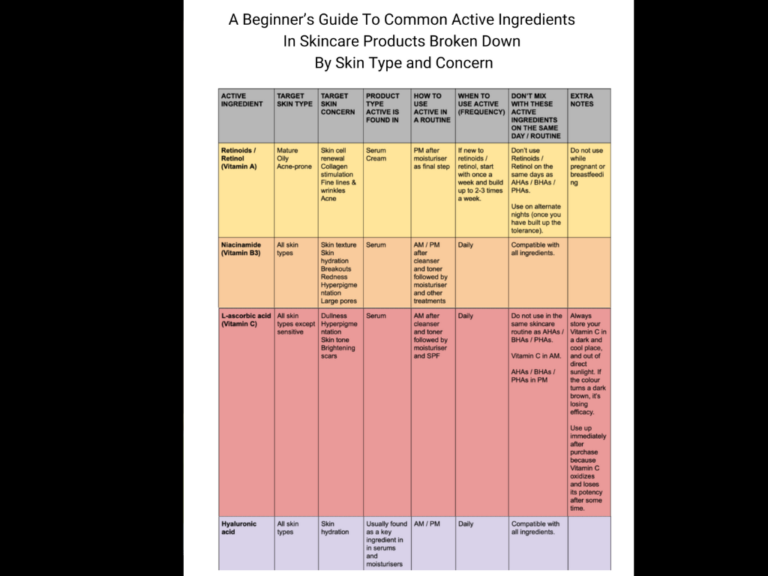Affordable Skincare Routine To Soothe and Reduce Acne Redness
Here’s my go-to affordable skincare routine to reduce inflammatory acne redness and soothe active breakouts. I think it’s important to be upfront that this routine will not fix acne breakouts overnight; it takes a week or so, but the results last and that’s what you really want.
Table of Contents
Inflammatory acne VS non-inflammatory acne
There are two types of acne:
Inflammatory acne is cause by overproduction of C. acnes bacteria in a clogged pore, which then results in redness, heat, and swelling (aka inflammation). If it’s deep cystic acne, then you will experience pain too. These kinds of breakouts take much longer heal due to the inflammation and can leave scars.
Non-inflammatory acne is cause by the build of excess sebum (oil) and dirt, which clogs the pores, and results in either a whitehead or black head. These tend to heal pretty quickly on their own within a few days without much effort.
How to reduce inflammatory acne redness
Given that inflammatory acne can take anywhere from 2-4 weeks to heal, it’s important to understand that patience and consistency are key for success.
So, here’s what I do to reduce inflammatory acne redness:
AM routine
Step 1: Cleanser
Use a gentle and hydrating facial cleanser. With the skin feeling irritated, I tend to avoid foaming cleansers and anything with active ingredients. Here are some of my preferred facial cleansers.
Step 2: Vitamin C serum
Apply a vitamin C serum because it has anti-inflammatory properties. Here are some of my favorite vitamin C serums.
Step 3: Moisturizer
Use a very gentle moisturizer to hydrate the skin. This also helps to repair the irritated skin barrier.
Step 4: Sunscreen
Apply a lightweight, hydrating, and non-comedogenic sunscreen during breakouts and inflammation. These are some of my favorite sunscreens for acne prone skin.
PM routine
Step 1: Double cleanse (oil cleanser + facial cleanser)
Double cleanse using a gentle oil cleanser followed by a facial cleanser. As mentioned above, use a gentle gel and hydrating cleanser.
Step 1A: Salicylic acid toner – on alternating nights
On the nights when you do not use a niacinamide serum, use a salicylic acid tone to help clear out pores and keep further breakouts at bay.
Step 2: Hydrating essence (aka ‘skin’ in K-beauty)
Use a hydrating essence with soothing ingredients like centella Asiatica, green tea or chamomile. The extra hydration protects the skin barrier while soothing the skin, helping it heal. My favorite essences are from the brand Innisfree — try the Green Tea Seed Skin.
Step 2A: Niacinamide serum
On the nights when you do not apply a salicylic acid tones, use a niacinamide serum to help reduce inflammation and redness. It also helps with evening out skin texture.
Step 3: Moisturizer
Apply a non-comedogenic hydrating moisturizer. Stay clear of fragrance and products with active ingredients because they may further irritate the skin. You want to use something simple and gentle.
Related:

A few more notes about reducing inflammatory acne redness
This routine takes 2-3 weeks to show full results
Inflammatory acne takes up to 2-3 weeks to fully heal because the infection is deep in the pores. So, be patient and consistent with the routine above and what you will see is that the skin actually heals (it becomes glowy and clear) and, in my experience, will stay that way in the long-term (unless there are some other factors that cause more breakouts). You may not see any results for the first week, just so you know.
Cleansing and hydrating are key
You might be tempted to try strong products and active ingredients as a “quick fix” for inflammatory acne redness, but trust me, these will only make things worse. Like I said, it’s a deep infection in the pores, so you need to be patient while it clears and heals. So, the secret to healing acne redness and soothing breakouts is actually to be very consistent with cleansing and hydrating the skin. This helps to keep any further bacteria, oil and dirt, which can cause more breakouts, away and ensure the skin is healing. I can’t stress enough what a difference just being diligent about cleansing and hydrating the skin can make.
Keep it simple and gentle
Skip the harsh products; limit use of actives to only salicylic acid other acne treatment products; and don’t try any new products. You wouldn’t put soap or anything else harsh on an open cut or graze, so the same applies for inflammatory acne. They are essentially open wounds on the face and you have to be gentle as they heal.
Switch to a silk pillow case
I switched to using a silk pillow case a few years ago and it has really helped reduce my acne, in general. So, I’d say make the switch permanently, if you do have acne prone skin, but especially when you are trying to heal inflammatory acne, a silk pillow case will help prevent further irritation to active pimples and cysts.
Use makeup sparingly
As long as you are cleansing and moisturizing properly day and night, it’s okay to use some makeup. Whenever I have a breakout, I tend to make a few changes to my routine:
- Skip foundation. Instead, use concealer to spot conceal and set face with a lightweight loose powder.
- Use powder blush and bronzer very lightly. Avoid highlighter since this will emphasize texture and pimples.
- Emphasize the eyes to draw attention away from breakout zones





